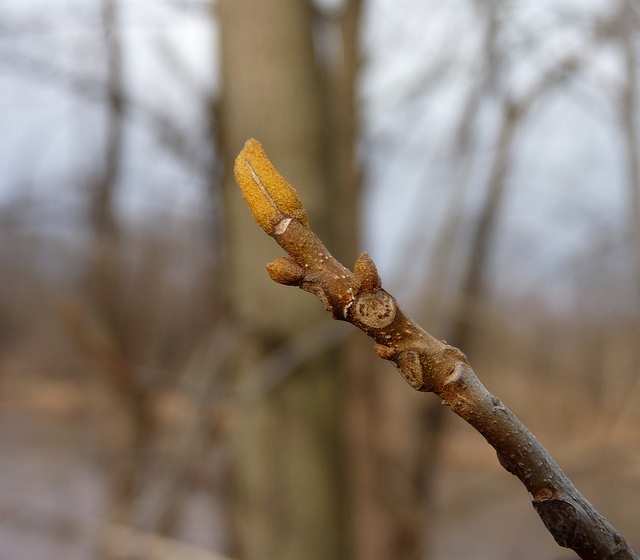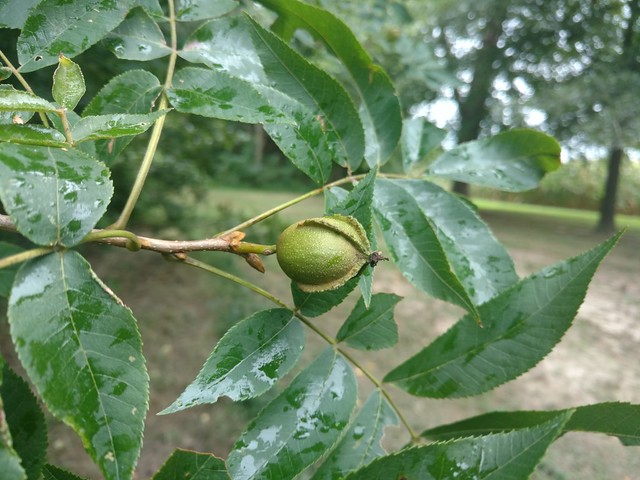Bitternut Hickory
Carya cordiformis (Wangenh.) K. Koch
Description
Bitternut hickory is a member of the walnut family (Juglandaceae). Other common names include bitter hickory, bitternut, bitter pecan, pig hickory, red hickory, swamp hickory, and white hickory ². Carya cordiformis is a 60 to 80-foot tall tree with a life span up to 200 years ². It has smooth, gray bark forming flat but not scaly ridges. The long, scaly, yellow buds are distinctive². It has alternate leaves are 6 to 12 inches long and have 7 to 9 serrated leaflets ¹. Male and female flowers are found on the same tree (monoecious). Male flowers are in 3 to 5 inch catkins². Female flowers are small. They produce a nut with thin yellow-green husks that form four ridges along the lines where they split ¹. Nuts are not produced until the tree is 30 years old² . The nut is bitter giving rise to its common name¹.

Bark of bitternut hickory. B. Hubick, Maryland Biodiversity Project ³

Distinctive yellow buds of bitternut hickory. J. Beetham, Maryland Biodiversity Project³

Leaflets and ridged nut of bitternut hickory. W. Longbottom, Maryland Biodiversity Project ³
Distribution
Bitternut hickory is native to mainly the eastern half of the United States, especially in the northern and northeastern United States and southern Canada to Iowa and south to Georgia 4. It grows in moist valley bottoms, but can tolerate dry slopes and poor soils 4. It is considered shade intolerant, but may grow in shade in moist areas 4. In Maryland bitternut hickory can be found throughout the entire state with exception of Allegheny, Dorchester and Wicomico counties ³.
Natural distribution of bitternut hickory. 5
Wildlife Importance
Some small mammals such as beavers, small rodents and rabbits partially rely on the bark for a food source when other sources are scarce 4. Because of the high astringency, seeds are not normally consumed by humans 4. Bitternut hickory is host to 231 caterpillars of Lepidoptera 9. Some moth species greatly rely on them as a source of food. These species include luna moth (Actias luna), regal moth (Citheronia regalis), and several underwing moths (Catocala sp.) 4,6.
Economic Importance
The bitternut hickory does not have much direct economic importance for consumption due to its astringency 7, however it does have great importance when it comes to smoking meats 4. In addition to curing meat, it is burned as a fuel source 4. The wood may be used for crates, flooring or veneers 7. Historically, Native Americans used it as spices when cooking and occasionally used nuts to bake into breads and other foods 7.
Threats
Because of its thin bark, bitternut hickory is susceptible to fire 4. The most damaging disease is white heart rot (Poria spiculosa) that can produce extensive damage to the wood 4. Bitternut hickory has a few specific insect pests. One is the walnut caterpillar (Datana integerrima). They tend to feed on leaves and can defoliate small or medium trees, which is usually not a problem unless the same tree is affected in consecutive years 8. Another common pest is hickory shoot curculio (Conotrachelus aratus) that bore into the younger branches to lay eggs that hatch the following year 6 . The hickory bark beetle (Scolytus quadrispinosus) is the most important bark beetle attacking bitternut hickory 4.
Interesting Facts
- The genus name Carya comes from the greek “karya” for walnut and the specific epithet cordiformis comes from the Latin “cordata” referring to the fruit husks 10.
- Bitternut hickory’s high leaf calcium content makes it valuable for improving soil quality 6.
References
- Missouri Department of Conservation: Butternut hickory
- North Carolina State Extension: Carya cordiformis
- Maryland Biodiversity Project: Bitternut Hickory
- USDA Foresat Servicem Silvics, Vol. 2, Hardwoods: Carya cordiformis
- Virginia Tech Dendrochronology: Bitternut hickory
- City of South Bend, Venues, Parks and Arts: Bitternut hickory
- Miami University, M. Wood–The bitternut hickory: Carya cordiformis
- University of Kentucky Entomology: Hickory
- Leaves for Wildlife: Bitternut hickory
- Missouri Botanical Garden: Carya cordiformis
Contributed by R. Glorioso and A. Kozlov

